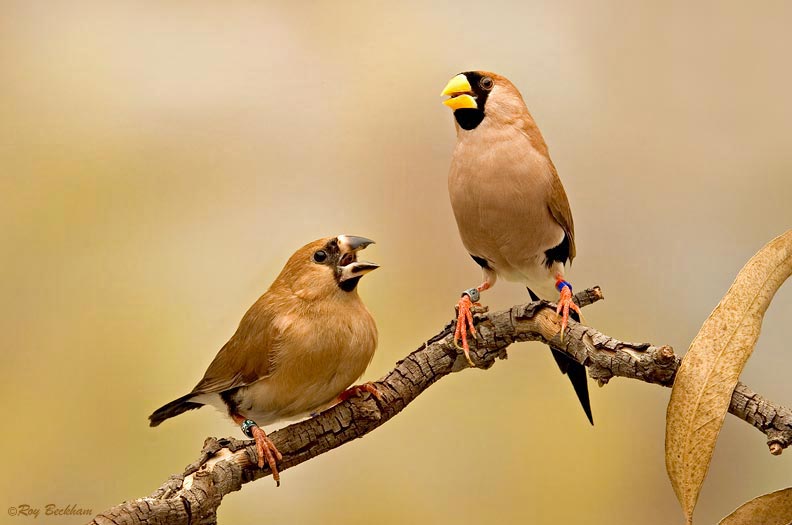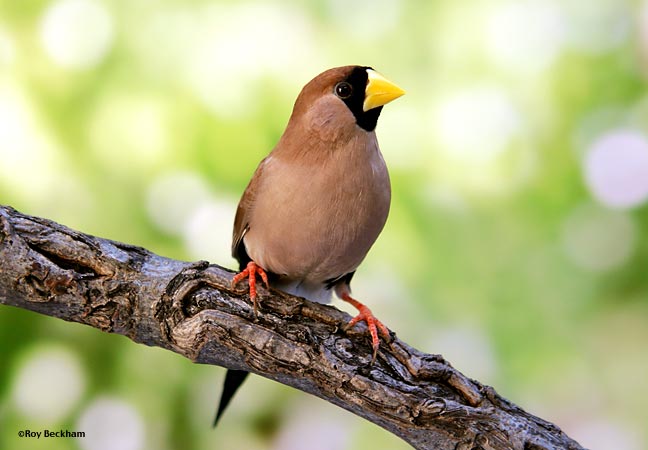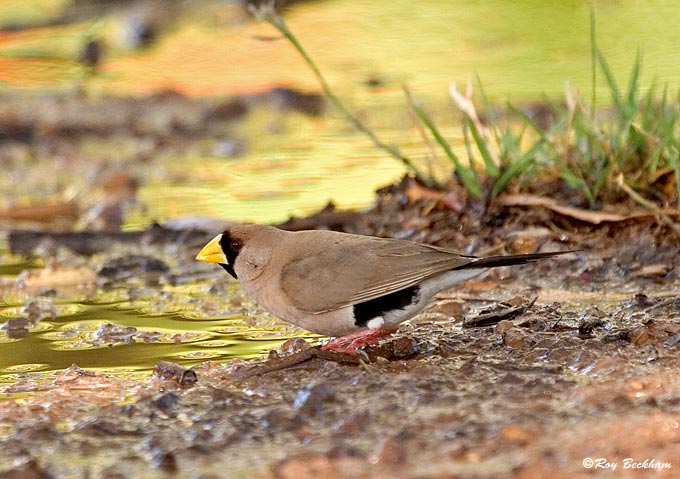|
Common Names
Masked Finch
Description
The Masked Grassfinch can be difficult to sex. Males and females are nearly identical in appearance. When seen in a group, the male's face mask may extend further back on the top of the head than the female which will have a very narrow band of black next to the beak. The "trouser stripe" behind the legs can also be wider on the males. Beak color can be a richer yellow in males, but quite often this is more an indication of condition rather than of sex. Males will of course have a courtship song.
Diet
A standard finch mix will be fine with Masked Grassfinches. They eagerly take egg food (Roy's egg food), greens and soaked millet or sprouting paddy rice. Grit and calcium in the form of crushed egg and oyster shells and cuttlebone should always be available to them. I don't offer live food and they really don't show any interest in it anyway.
 Juvenile Masked Grassfinch (left) with parent. (click to see a wild Masked Grassfinch feeding young fledglings) Juvenile Masked Grassfinch (left) with parent. (click to see a wild Masked Grassfinch feeding young fledglings)
Breeder's Notes
The first step is getting a true pair. I've had more than my share of difficulties in determining the sex of these birds. They are such peaceful birds that there is no squabbling between pairs or individual males. They just seem to get along. Because of this, they can seem like they are doing just fine as a pair when in fact they are either not of the opposite sex or just not a compatible pair. I have DNA sexed the birds that I could not identify before setting them up. Once a compatible pair is set up though, they will usually construct a nest fairly quickly. I provide them with either a half open nest box or a hole opening type of box. The half open seems preferred. I provide coconut fiber for the base of the nest and then a few soft feathers or burlap like material for them to line the nest. A clutch of 4-6 eggs is pretty much the norm and both sexes share in the incubation duties. The eggs will hatch around the 13th day and the young fledge between 18-21 days. Best to just leave these birds alone as much as possible when they are sitting and raising young. Otherwise they will likely abandon the nest.
Masked Grassfinches can be readily fostered under Society finches or even Zebra Finches. It would be best to place the young with other Masked Grassfinches as soon as they are eating on their own. Like the Gouldian finch, I believe that the Masked Grassfinch was saved in aviculture by the use of fostering, but that with some work the Masked Grassfinch can be enticed to raise their own.
Additional Notes
There is one subspecies of the nominate form called the White-eared Masked Grassfinch (Poephila personata leucotis). The subspecies is from the Cape York penninsua area, whereas the nominate species is found in the Kimberley region and across the Top end of Australia. I do not believe that the White-eared subspecies exists in U.S. aviculture. It is rare even in Europe. It looks very similar to the nominate form with a white area behind the face mask and some white in front of the trouser stripe.
While the Masked Grassfinch is commonly seen in mxed flocks with the Shaft-tail finch, it is best not to keep these birds together in a colony where they may hybridize. They also should not be kept with Parson finches. Unfortunately, it is reported that the hybrids are fertile.
I band these birds with a 2.5mm or "C" sized band.
See the mouth markings of nestling Masked Grassfinches.
|












